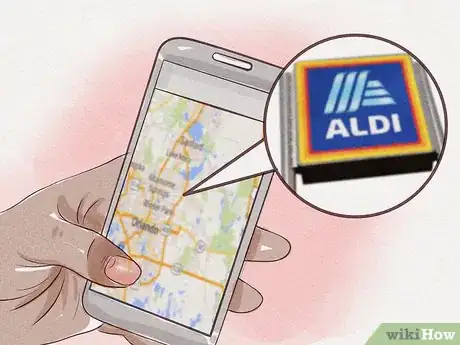This article was co-authored by wikiHow Staff. Our trained team of editors and researchers validate articles for accuracy and comprehensiveness. wikiHow's Content Management Team carefully monitors the work from our editorial staff to ensure that each article is backed by trusted research and meets our high quality standards.
There are 8 references cited in this article, which can be found at the bottom of the page.
This article has been viewed 21,837 times.
Learn more...
Shopping at Aldi is a little different from visiting other grocery stores, so it can be useful to keep a few pointers in mind before planning your first trip. Check to see how late your nearest location is open, as hours often vary. Bring your own reusable shopping bags or grab an empty box from one of the nearby shelves. Keep an eye out for deals while perusing the store’s selection of affordable store-brand products. Once it’s time to check out, lend a hand with the unloading and bagging to keep things moving.
Steps
Planning Your First Trip to Aldi
-
1Locate an Aldi store in your area. Head to the Aldi website and use their Store Locator feature to search for locations near you. The popular chain is ever-expanding, with new stores opening up all the time. Chances are good that you’ll be able to find one within a reasonable distance.[1]
- Aldi currently has more than 1,600 locations across the United States, along with stores in Europe and Southeast Asia.
- If you happen to be driving by, Aldi stores are recognizable by their blue and orange signs bearing their signature “A” logo.
-
2Check the store’s hours. Unlike other grocery stores, Aldi only stays open during peak business hours. In most places, this will be from around 9am-8pm throughout the week, and 10am-7pm on weekends. Schedule accordingly to find time to get your shopping done.[2]
- Drop by your neighborhood location to peek at their posted hours, or run a quick search online to find out exactly when they’re open.
- Closing early cuts down on the overall cost of operation, which allows the company to keep prices lower for their customers.[3]
Advertisement -
3Look over the weekly specials. Every Wednesday, Aldi circulates a flyer containing a list of sale items not only for the coming week, but the following week as well. This affords busy shoppers the luxury of planning in advance. As you draw up your grocery list, review the store specials to find deals on the essential items you need, like meats, produce, milk, and snack foods.[4]
- A digital version of the 4-page flyer can be found on the Aldi website or through their official app. You can also pick up a physical copy as soon as you walk in the store.[5]
- The flyer laying out the next week’s specials is usually posted in the store window to give customers a sneak peak on their way out.
-
4Be prepared to pay a quarter for a shopping cart. While Aldi does make shopping carts available for those toting around big hauls, their system works a little differently than most grocery stores. As you approach the line of shopping carts, you’ll notice that each has a small box near the handle. Insert a quarter into the slot to release the cart. You’ll get your quarter back when you return the cart.[6]
- Aldi’s shopping cart “rental” system is yet another cost-saving measure designed to keep their stores neat and organized.
Picking up What You Need
-
1Bring your own shopping bags. Come prepared with your own reusable bags, or feel free to use one of the many empty (or nearly empty) cardboard product boxes lying around the store. Even if you’re using a shopping cart, you’ll need to have a way to carry your groceries out to your car after you’ve been rung up.[7]
- It is possible to request paper or plastic bags at the checkout line, but these will cost you a few cents extra.
- Eliminating paper and plastic waste is part of Aldi’s mission to make regular grocery shopping more cost effective and environmentally friendly.[8]
-
2Browse the selection of store-brand goods on display. Make your way down each aisle, scanning for the items on your list. If it's your first time shopping at Aldi, it won't take you long to notice that they don’t carry any of the name brand products you’re used to seeing. Instead, the shelves are stocked with a limited assortment of Aldi-specific labels.[9]
- Cutting down on the number of brand names allows stores to narrow down their inventory to basic, high-quality products—and charge less in the process. The items they offer tend to be the same quality as more notable brands, but with a much small price tag.
- Veteran Aldi shoppers agree that the store’s products stack up to the better-known name brand goods. If you’re loyal to a certain brand, however, or you’re unable to track down a particular variety, you may need to make a separate trip to a big-brand chain.
-
3Look for prices on the product containers. Most of Aldi’s merchandise is stocked in the same boxes it came shipped in. Rather than having to hunt for tiny individual tags on every shelf, simply look above or below the display to find the big sign plainly displaying the price.[10]
- A smaller overall product selection combined with more obvious price listings means you’ll save time on frustrating comparison shopping.[11]
- You may also find the weekly sale price listed alongside the regular unit price in some stores.
-
4Check out the Special Buys section. Before you head to the checkout line, stop by the featured display in the center of the store and see what other deals you can take advantage of. This section brings together various specialty items, from holiday meal packages to housewares. The contents are constantly changing, so don’t forget to check back often.[12]
- The products in the Special Buys section are typically united by a common theme, like Halloween candy and decorations or Superbowl party snack solutions.
Checking out and Returning Items
-
1Unload your groceries at the checkout line. As soon as you reach the head of the line, begin laying out the items in your cart or shopping bags on the conveyor belt. Keep everything close together so it’s easier to scan. This makes the checkout process go much more smoothly, as your cashier won’t be forced to stop and unload everything for you.[13]
- If you need paper or plastic bags to carry out your haul, don’t forget to pay for them along with your groceries.
- Since Aldi stores operate with fewer employees, there ordinarily won’t even be a separate bagger at the checkout lane.
-
2Choose your preferred payment method. Once it comes time to pay for your groceries, you have a few options available to you. Cash is still one of the easiest ways to go, but you can also use a debit or EBT card. The company recently started accepting all major credit cards, as well, so you’ll never have to worry about digging through your wallet in a frenzy trying to find a different card.[14]
- The only forms of payment Aldi doesn’t accept are personal checks and WIC (Women, Infants, and Children) program cards.[15]
- Hold onto your receipt in case you decide to return something later.
-
3Help bag your own groceries. The cashier will ring you up and give you your total, then place smaller items back in your reusable bags. You’ll then proceed to the bagging counter near the front entrance of the store, where you can load up the rest of your groceries at your own leisure.[16]
- Occasionally, you’ll be able to find a few spare bags left around the bagging area.
-
4Return items to get your money back. Aldi is known for their double-back guarantee, which means if you’re dissatisfied with one of their products, they’ll not only offer you a new one, but also refund you the full purchase price. Just present the unused portion of the item to the store manager along with the original receipt and you’ll be given a replacement on the spot.[17]
- National brand products, alcohol, housewares, and other non-food items are among the only goods at Aldi that aren't eligible for returns.[18]
- Knowing that you have nothing to lose may help put you at ease about trying unfamiliar brands for the first time.
Community Q&A
-
QuestionI want to find out if Aldis will be carrying fruit trees this spring. I believe they have carried them in past years.
 Otterly BadgerificTop AnswererAldi stores do sometimes have fruit trees in the spring, such as citrus fruit trees, for example, lemons and limes. In order to find out if your store will carry them in the next spring, contact the Aldi store manager or send an email to the Aldi headquarters requesting this information.
Otterly BadgerificTop AnswererAldi stores do sometimes have fruit trees in the spring, such as citrus fruit trees, for example, lemons and limes. In order to find out if your store will carry them in the next spring, contact the Aldi store manager or send an email to the Aldi headquarters requesting this information.
References
- ↑ https://aldi.us/stores/
- ↑ https://www.myjoyfilledlife.com/2014/04/25/10-things-know-shopping-aldi/
- ↑ https://www.thekitchn.com/9-things-you-should-know-before-shopping-at-aldi-for-the-first-time-237213
- ↑ https://www.thekitchn.com/9-things-you-should-know-before-shopping-at-aldi-for-the-first-time-237213
- ↑ https://www.gimmesomeoven.com/aldi-101-how-to-shop-at-aldi/
- ↑ https://www.aldi.us/en/new-to-aldi/shopping-at-aldi/
- ↑ https://www.pennypinchinmom.com/ten-things-need-know-comes-shopping-aldi/
- ↑ https://www.aldi.us/en/new-to-aldi/shopping-at-aldi/
- ↑ https://www.aldi.us/en/new-to-aldi/shopping-at-aldi/
- ↑ https://www.gimmesomeoven.com/aldi-101-how-to-shop-at-aldi/
- ↑ https://www.pennypinchinmom.com/ten-things-need-know-comes-shopping-aldi/
- ↑ https://www.gimmesomeoven.com/aldi-101-how-to-shop-at-aldi/
- ↑ https://www.gimmesomeoven.com/aldi-101-how-to-shop-at-aldi/
- ↑ https://www.pennypinchinmom.com/ten-things-need-know-comes-shopping-aldi/
- ↑ https://www.aldi.us/en/about-aldi/faqs/method-of-payment-aldi-gift-cards-coupons/
- ↑ https://www.myjoyfilledlife.com/2014/04/25/10-things-know-shopping-aldi/
- ↑ https://www.thekitchn.com/9-things-you-should-know-before-shopping-at-aldi-for-the-first-time-237213
- ↑ https://www.aldi.us/en/new-to-aldi/double-guarantee/






























































